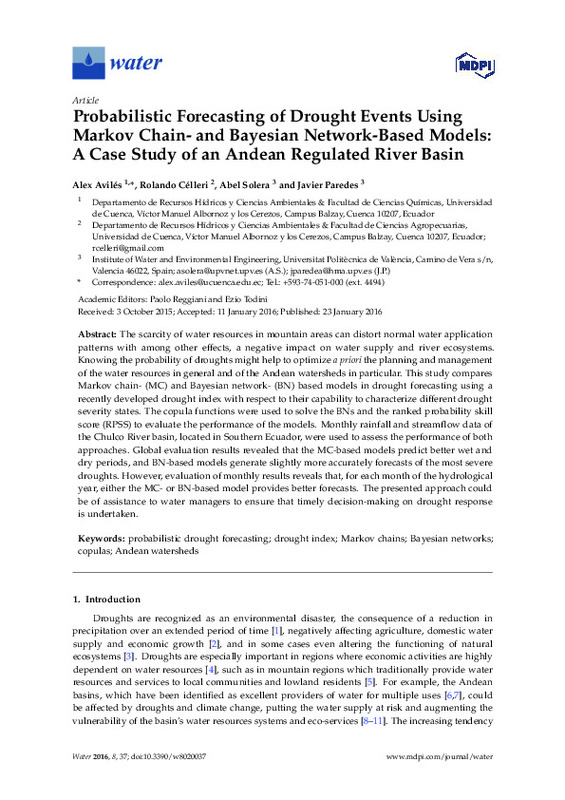JavaScript is disabled for your browser. Some features of this site may not work without it.
Buscar en RiuNet
Listar
Mi cuenta
Estadísticas
Ayuda RiuNet
Admin. UPV
Probabilistic Forecasting of Drought Events Using Markov Chain- and Bayesian Network-Based Models A Case Study of an Andean Regulated River Basin
Mostrar el registro sencillo del ítem
Ficheros en el ítem
| dc.contributor.author | Avilés-Añazco, Alex
|
es_ES |
| dc.contributor.author | Celleri, Rolando
|
es_ES |
| dc.contributor.author | Solera Solera, Abel
|
es_ES |
| dc.contributor.author | Paredes Arquiola, Javier
|
es_ES |
| dc.date.accessioned | 2018-01-12T12:55:32Z | |
| dc.date.available | 2018-01-12T12:55:32Z | |
| dc.date.issued | 2016 | es_ES |
| dc.identifier.issn | 2073-4441 | es_ES |
| dc.identifier.uri | http://hdl.handle.net/10251/94611 | |
| dc.description.abstract | [EN] The scarcity of water resources in mountain areas can distort normal water application patterns with among other effects, a negative impact on water supply and river ecosystems. Knowing the probability of droughts might help to optimize a priori the planning and management of the water resources in general and of the Andean watersheds in particular. This study compares Markov chain- (MC) and Bayesian network- (BN) based models in drought forecasting using a recently developed drought index with respect to their capability to characterize different drought severity states. The copula functions were used to solve the BNs and the ranked probability skill score (RPSS) to evaluate the performance of the models. Monthly rainfall and streamflow data of the Chulco River basin, located in Southern Ecuador, were used to assess the performance of both approaches. Global evaluation results revealed that the MC-based models predict better wet and dry periods, and BN-based models generate slightly more accurately forecasts of the most severe droughts. However, evaluation of monthly results reveals that, for each month of the hydrological year, either the MC- or BN-based model provides better forecasts. The presented approach could be of assistance to water managers to ensure that timely decision-making on drought response is undertaken | es_ES |
| dc.language | Inglés | es_ES |
| dc.publisher | MDPI AG | es_ES |
| dc.relation.ispartof | Water | es_ES |
| dc.rights | Reconocimiento (by) | es_ES |
| dc.subject | Probabilistic drought forecasting | es_ES |
| dc.subject | Drought index | es_ES |
| dc.subject | Markov chains | es_ES |
| dc.subject | Bayesian networks | es_ES |
| dc.subject | copulas | es_ES |
| dc.subject | Andean watersheds | es_ES |
| dc.subject.classification | INGENIERIA HIDRAULICA | es_ES |
| dc.title | Probabilistic Forecasting of Drought Events Using Markov Chain- and Bayesian Network-Based Models A Case Study of an Andean Regulated River Basin | es_ES |
| dc.type | Artículo | es_ES |
| dc.identifier.doi | 10.3390/w8020037 | es_ES |
| dc.rights.accessRights | Abierto | es_ES |
| dc.contributor.affiliation | Universitat Politècnica de València. Departamento de Ingeniería Hidráulica y Medio Ambiente - Departament d'Enginyeria Hidràulica i Medi Ambient | es_ES |
| dc.description.bibliographicCitation | Avilés-Añazco, A.; Celleri, R.; Solera Solera, A.; Paredes Arquiola, J. (2016). Probabilistic Forecasting of Drought Events Using Markov Chain- and Bayesian Network-Based Models A Case Study of an Andean Regulated River Basin. Water. 8(2). doi:10.3390/w8020037 | es_ES |
| dc.description.accrualMethod | S | es_ES |
| dc.relation.publisherversion | https://doi.org/10.3390/w8020037 | es_ES |
| dc.type.version | info:eu-repo/semantics/publishedVersion | es_ES |
| dc.description.volume | 8 | es_ES |
| dc.description.issue | 2 | es_ES |
| dc.relation.pasarela | S\299836 | es_ES |








